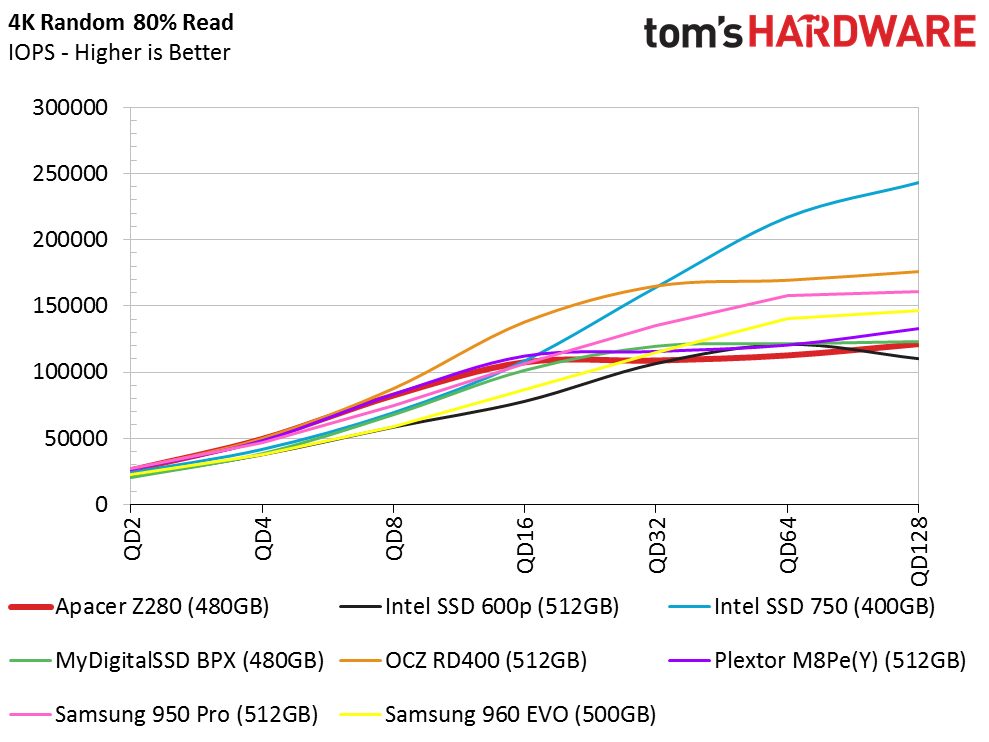Apacer Z280 NVMe M.2 SSD Review
Why you can trust Tom's Hardware
512GB NVMe SSD Performance
Comparison Products
512GB-class NVMe SSDs are the most contested capacity point, so there is no shortage of options. M.2 SSDs offer a limited amount of space for surface mount components. We've seen some designs with more than four NAND packages, but they are rare. Samsung is the only company with the resources to build the controller and DRAM in the same package to save space. It's possible to reach 1TB with just four NAND packages, but it requires very dense NAND with 16 die per package. The high-density packages are in short supply and are currently cost prohibitive for consumer products, which is why we see so many companies release 512GB models as the highest capacity in the M.2 form factor.
Pricing is very diverse at this capacity point. The Intel 600p 512GB with TLC NAND and MyDigitalSSD BPX 480GB lead the charge at $179.99, with the latter being the better value. The Plextor M8Pe sells for $249.99 in the M.2 2280 form factor with a factory-installed heatsink. The OCZ RD400 moves the pricing bar nearly $100 from where we started--it retails for up to $274.99. The other TLC-based drive on our list, the Samsung 960 EVO 500GB, sells for $284.99. Oddly enough, the two most expensive SSDs in the 512GB-class are the original consumer NVMe products. The Intel SSD 750 400GB sells for $329.99, and the Samsung 950 Pro tips the scales at $472.99.
Sequential Read Performance
To read about our storage tests in-depth, please check out How We Test HDDs And SSDs. We cover four-corner testing on page six of our How We Test guide.


The Apacer Z280 480GB outperforms the BPX 480GB at low queue depths during the sequential read workload. The performance profile leads us to believe the Z280 uses the same NAND as the Corsair Force MP500 and Patriot Hellfire M.2, but it retails for less than both of those E7-based NVMe SSDs. The BPX is the only E7 that we know of that harvests NAND from SanDisk wafers as opposed to Toshiba wafers. SanDisk and Toshiba manufacture their NAND in the same facility and use the same process, but each company programs the flash differently.
The Z280 also outperforms the two Intel SSDs at low queue depths. The other products have a firm lead over the Z280, but as we've already discussed, pricing increases rapidly with NVMe products.
Sequential Write Performance
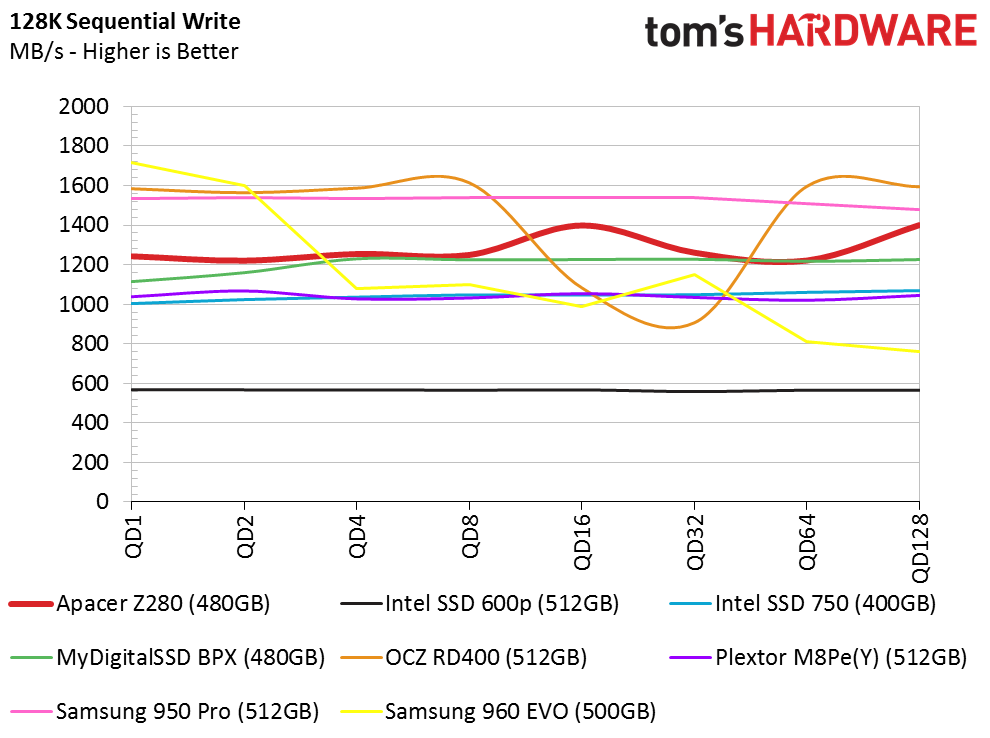

For the most part, MLC-based NVMe SSDs deliver a static line of sequential write performance with variation coming from thermal throttling or multiple CPU cores simultaneously accessing the SSD. The Z280 delivers a little over 1,200 MB/s of performance at QD2.
Random Read Performance



The Apacer Z280 480GB is one of the first E7-based M.2 SSDs to surpass 10,000 random read IOPS at QD1. Phison worked hard to reach this goal with its E7 controllers. The Z280 scales well as the workload intensifies. At QD4, the Apacer trails only the two Samsung NVMe SSDs.
Get Tom's Hardware's best news and in-depth reviews, straight to your inbox.
Random Write Performance



What the Z280 made up in low-QD random read performance, it loses in random write performance. The Z280 is nearly 10,000 IOPS slower than the MyDigitalSSD BPX at QD1. It also delivers the lowest random write performance of all the drives in the 512GB-class test pool.
80 Percent Mixed Sequential Workload
We describe our mixed workload testing in detail here and describe our steady state tests here.
There is a massive difference in mixed sequential performance between the Z280 and the BPX, which is the only other drive in the chart with the same E7 controller. The Apacer is nearly as fast as the OCZ RD400 in this test.
80 Percent Mixed Random Workload
The mixed random test shows that all of the drives are very capable and provide comparable performance at low queue depths.
Sequential Steady-State
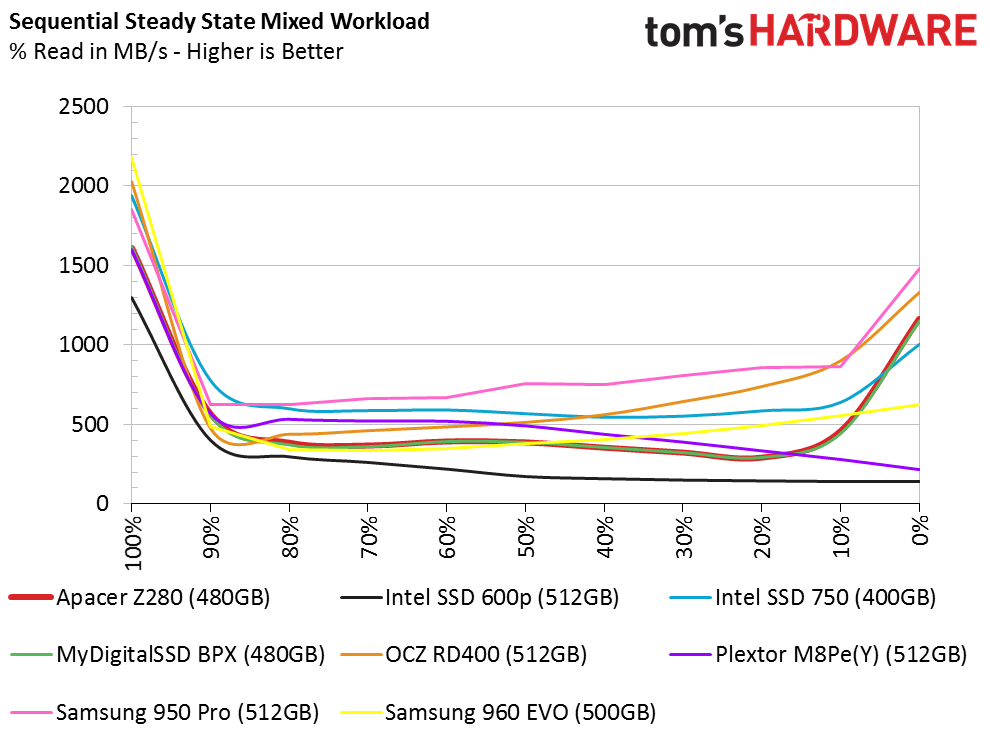


The BPX and Z280 provide nearly identical performance with sequential data under steady-state conditions. MLC flash has a large advantage over TLC during write workloads, and we see that advantage emerge at the end of the scale--the Z280 outperforms both the Intel 600p 512GB and Samsung 960 EVO 500GB.
Random Steady-State


We've yet to test an E7-powered SSD that delivers competitive performance in our write consistency tests. We're not sure how we feel about these drives in RAID, but we plan to investigate in the very near future.
PCMark 8 Real-World Software Performance
For details on our real-world software performance testing, please click here.



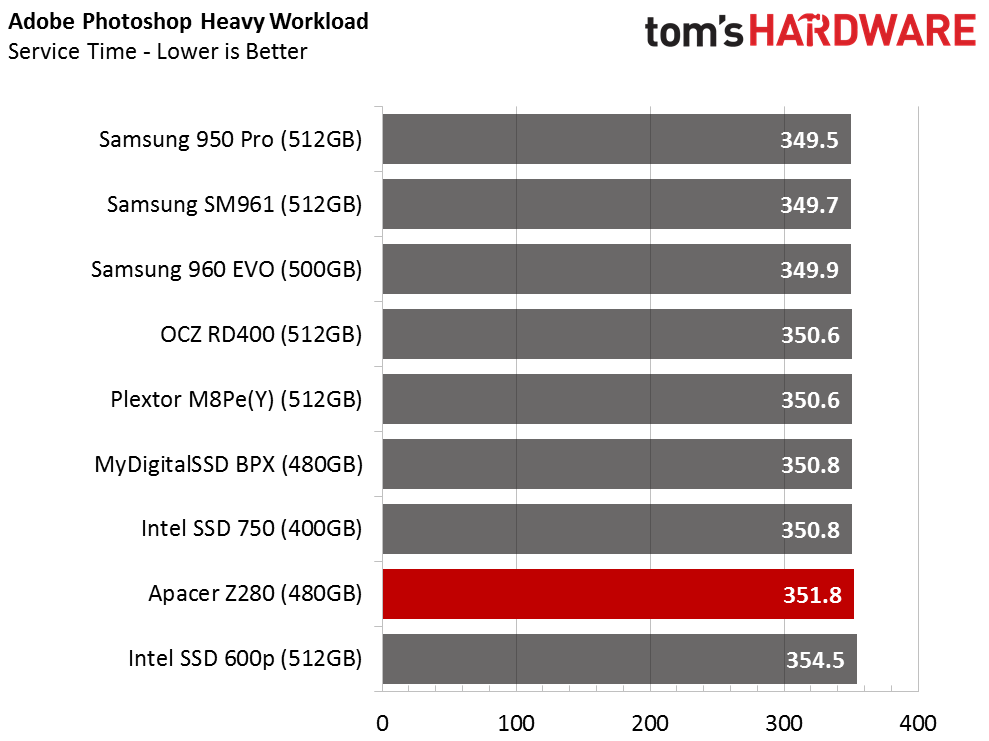


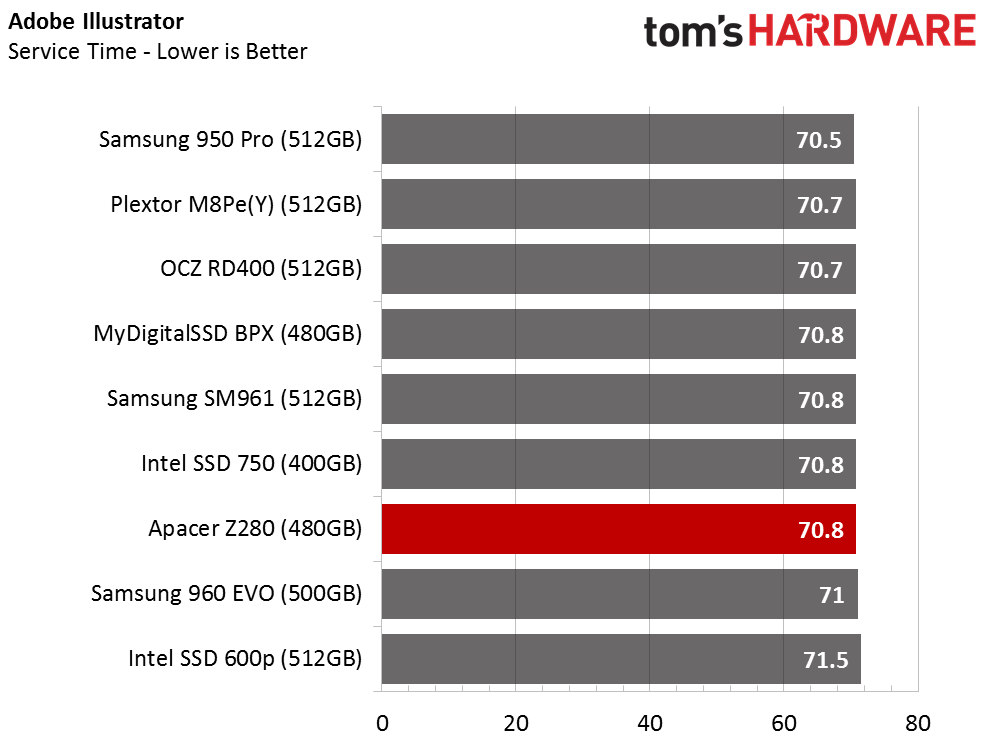



The Samsung 950 Pro still has a large performance lead over the competition, but the MLC SSDs are somewhat evenly matched as we move down the list.
Application Storage Bandwidth
We expected the Apacer Z280 to outperform the MyDigitalSSD BPX when we average the results and present them as throughput, but that wasn't the case. The Z280 480GB is still a very capable SSD but it falls short of the BPX, which is the fastest E7 SSD in application workloads.
PCMark 8 Advanced Workload Performance
To learn how we test advanced workload performance, please click here.



They have the tale of the tape in boxing, and PCMark 8's extended storage test is our equivalent. During the moderate workload results (third chart in the series), the BPX runs just a little faster than the Z280 as it emerges from an extended workload. Both drives recover well, but neither is the fastest available.
Total Service Time



The service time test doesn't reveal any latency surprises that would lead to an adverse user experience. The Z280 is a solid product that outperforms all SATA-based SSDs on the market, and it sells for a value price, too.
Disk Busy Time
We use the disk busy time test to isolate issues that can lead to poor notebook battery life or other abnormal behavior. The Phison PS5007-E7 controller has other issues related to power consumption that we will examine later in the review.
Responsiveness Test


The Responsiveness Test is part of BAPCo's new SYSmark 2014 SE suite. We run three test iterations on a Lenovo Y700-17 while the software measures latency and power consumption for the whole system. The Z280 trails the BPX's performance again, but the power consumption metrics are nearly identical.
Notebook Battery Life


The Phison E7 NVMe 8-channel controller has abysmal idle power consumption, which makes it a poor choice for notebooks that routinely run on battery power. Phison has yet to build a custom NVMe driver that could alleviate some of the power issues. That said, custom drivers don't guarantee reduced power consumption. The Samsung 960 EVO 500GB uses a custom NVMe driver that actually increases power consumption compared to the in-box Microsoft driver.

Chris Ramseyer was a senior contributing editor for Tom's Hardware. He tested and reviewed consumer storage.
-
serendipiti Just wondering if it's possible to install OS and boot from NVMe drives (with PCIe adapters) on older motherboards by using one SATA HDD or SSD to start the windows loader and from there start the OS on the NVMe drive. The boot time would suffer, but then you should get the OS running from the NVMe drive. Not sure if there would be trouble with the drive letter assignment (but I've seen some smart cloning utilities that dealt with the drive letters reassignment)Reply
Going through a VM placed on the NVMe drive makes any sense ? -
svan71 https://forums.anandtech.com/threads/full-nvme-support-possible-for-older-intel-chipsets.2437588/Reply -
serendipiti svan71 thank you...Reply
Dealing with UEFI Bios firmware it's what I tried to avoid...
"As far that I know, there are several ways that you can use to load UEFI Drivers. One of them is having the UEFI Drivers integrated in the Firmware, which is what you did, but they may also be loaded as files from a disk's EFI System Partition. A previous idea I had was that you could format an USB Flash Drive in GPT with an ESP containing the NVMe Driver EFI executable, which could be loaded by UEFI, so it can provide NVMe support on older platforms. However, I don't recall anyone testing that way. Not even close as good as integrating them, but if it fails, it may also be worth a try." -
Bruce427 @ Chris,Reply
I purchased a 240GB MyDigital BPX around Thanksgiving on 2016.
It is likely that I have the latest firmware update? And if not, where can I download it?
Thank you,
Bruce -
Bruce427 Where can the latest firmware be downloaded? I didn't see it on MyDigital's website under firmware updates.Reply




